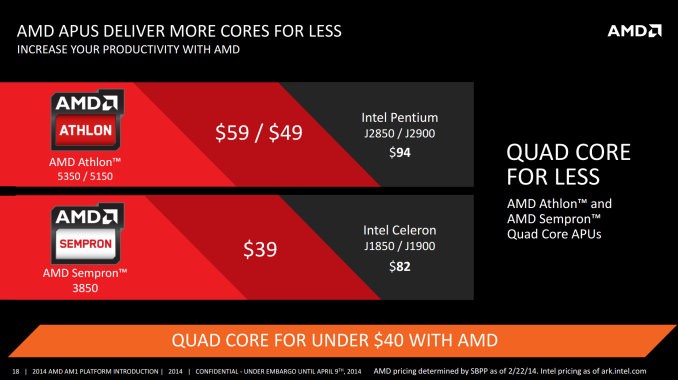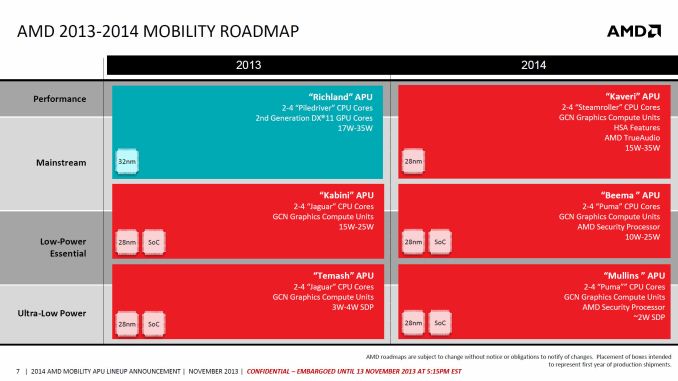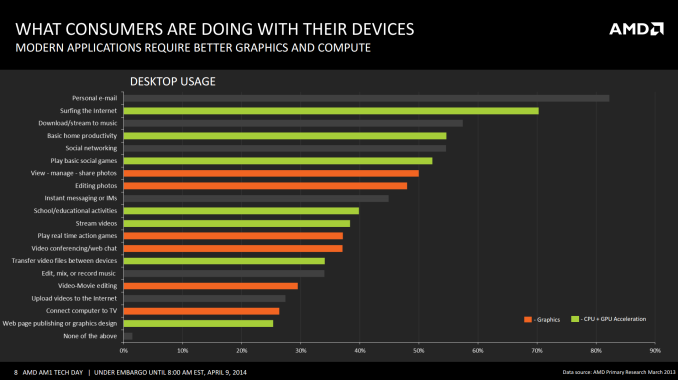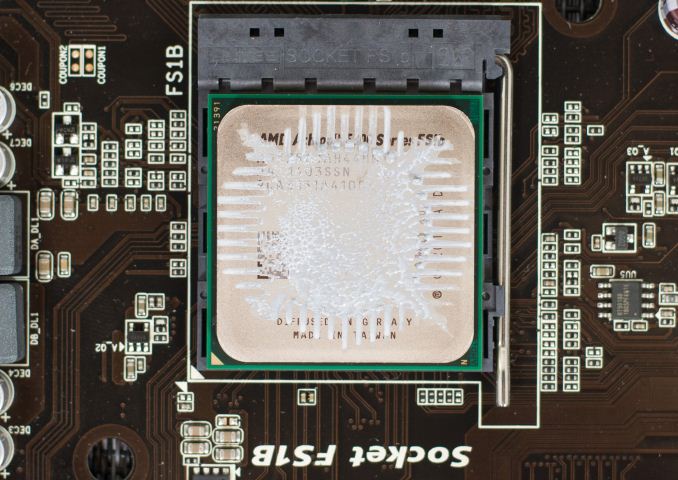The Desktop Kabini Review Part 1: AMD Athlon 5350 (AM1) Tested
by Ian Cutress on April 9, 2014 8:00 AM ESTFinal Words
As mentioned in our test setup, the benchmark results in this preliminary article are only a small fraction of our normal coverage. Due to other commitments we were unable to run every test on all comparison systems, but we have the other Athlon and Sempron APUs as well as comparable Intel counterparts coming in for review.
The poignant place to start with the final analysis is AMD’s claim of ‘Quad Core for Less’. In this statement alone, they are not wrong. Intel cannot provide a socketed quad core processor for less than $36 (Sempron 3850). The cheapest all-in-one desktop quad-core system from Intel equips the Celeron J1900 onto a motherboard for $92, which is exactly where AMD sit with the top-end Kabini based Athlon 5350 with a motherboard. One of the issues to consider at this point however is that Intel offers several dual core options (non-Atom) around this $40-$60 price point, and in many cases the IPC and CPU speed advantage of these cores is greater than that provided by Kabini, particularly in single threaded applications. The only downsides to this solution are the power consumption is higher, and the motherboards are more expensive. For a competitive socketed Intel dual core, a motherboard plus CPU can be in the region of $110-$120 at 35W-55W.
The big upside and selling point from the AM1 Kabini platform should be upgradeability. If a user buys an AM1 platform now, they should be able to upgrade it in the future. While AMD has not yet confirmed if Beema is coming to the socketed platform, the roadmaps suggest that the laptop sockets are remaining consistent from Kabini to Beema. This should imply that if Beema gets a socketed version, it should also remain based on AM1/FS1b.
If we compare single threaded performance between Kabini and our J1800 test system, the benchmarks are almost even between the two, particularly when it comes to synthetics such as Cinebench, but falls behind on emulation such as the Dolphin Benchmark and 3DPM. The integrated graphics of the Kabini pull ahead when it comes to gaming, despite the single channel memory interface.
|
AMD Athlon 5350 vs. Intel Celeron J1800 Single Threaded |
||
| Athlon 5350 | Celeron J1800 | |
| Cinebench R10 | 1967 | 1917 |
| Cinebench R11.5 | 0.51 | 0.49 |
| Dolphin Benchmark | 40.4 | 38.02 |
| 3DPM | 53.29 | 69.20 |
When placing Kabini against any Intel Ivy Bridge socketed processor, the increased IPC and frequency pushes the system above the Kabini, in exchange for more power and a more expensive system overall. If we compare the Kabini single-threaded results to those of the Celeron G465, a Sandy Bridge based single core CPU at 1.9 GHz, the Celeron does pull ahead on the majority, but fails miserably in the graphical benchmark suite.
|
AMD Athlon 5350 vs. Intel Celeron G465 Single Threaded |
||
| Athlon 5350 | Celeron G465 | |
| Cinebench R10 | 1967 | 2975 |
| Cinebench R11.5 | 0.51 | 0.73 |
| Dolphin Benchmark | 40.4 | 38.8 |
| 3DPM | 53.29 | 59.98 |
Does it seem particularly odd that a modern Kabini architecture at 2 GHz cannot keep up with a 3 year old Sandy Bridge processor at 1.9 GHz at our simple benchmarks? AMD is leveraging on the fact that much of what we do on a computer as a casual user can leverage the fixed function units of the graphics center of the APU:
AMD’s key in all of this is leveraging the GPU. For non-GPU intensive tasks, on paper, the J1900 for $92 and 10W TDP would seem to be the choice if upgradability is not a concern. The remit of AM1 and Kabini could be extended if motherboard manufacturers decided to use those extra PCIe lanes. Consider an AM1 with controllers to make a nice routing system (4x NIC) or something based around storage (SATA controllers and hubs). But because Kabini is also a cost play for AMD at the low-end desktop segment, margins are going to be ultra-tight for motherboard manufacturers and I do not imagine that as much effort will be put into making innovative products as the rest of their product range on other sockets.
In order for the upgradability angle to work, AMD need to keep the sockets around for at least two generations. AM1 comes late in Kabini’s life cycle, given that Beema on the mobile side is due out later in 2014. It would make sense for AMD to release Beema desktop parts, but the big question there is when. AMD could launch new processors on day 1 of Beema, or further into the life cycle. I would imagine that depends on what the competition does. AMD does have that advantage of having an upgradeable platform before Intel; however Intel may see the market differently. It is a hard one to judge.
Stay tuned for our full benchmark suite on the other AMD Kabini APUs.














126 Comments
View All Comments
macs - Wednesday, April 9, 2014 - link
I know it's only part one. Anyway it's pretty much useless. I think that on low cost platform like this power consumption for a file server and htpc quality are way more relevant than playing tomb raider or borderlands...DudemanX - Wednesday, April 9, 2014 - link
I don't disagree with any of that but then why have the game benches at all? Even if they just show us how they get unplayably crushed at 1920x1200xHigh quality settings at least we would be able to see how the IGP power is relative to the discrete chips. I'm just wondering for whom these 1280x1024 numbers are for.hero4hire - Saturday, April 12, 2014 - link
Bought a H81 for $60, haswell g1830 Celeron for $30. There were cheap $40 boards available. I'm not sold on this chip as graphics performance are rapidly increasing while cpu not. Why hamstring myself to graphics target in upgrades (socketed) when any $20 graphics "accelerator" will be better. Plus I know have a real upgrade path graphically if needed.azazel1024 - Wednesday, April 9, 2014 - link
For a really cheap, low power system, the AMD Kabinis might work.However, looking at what they offer, they can't replace my server with a lower power version. Only 2 SATA3 slots, which means I'd need to throw a RAID card on there of some sort, even a lot end one would add a lot to the price and a lot more to the power consumption.
My G1610 based system ran $92 for CPU+board ($42 processor, $50 board on sale). It can run rings around even the best Kabini here. Yes, it is 55w versus 25w. That is one of the big things I see missing from this review, was actual power consumption of those Sandy/Ivy celeron systems and the J1800 and the Kabini. What are we talking practical power consumption? I use my server as a file server, itunes server, calibre server and download server. It doesn't need a ton of grunt...but in some use cases, I could see it being bogged down with something like a Kabini (or even the Bay Trail based ones) pretty badly. Like updating iTunes library entries and such forth.
TDP isn't the only story though, idle power consumption is probably lower on the Kabini than mine...but my TOTAL system power consumption is 21w at idle, 33w streaming video and only 51w under max CPU load (with HDD spun up too, which add around 12w of load for them when not parked). So between idle and max, the CPU has only a dW of 20w, and possibly a little less as the network cards are somewhat more active to, which might be accounting for a watt or so there.
I know that the CPU is pretty power efficient at idle, though I am sure it could be better...so the CPU itself might be consuming 6-10w at idle and only hitting maybe 30w max under load.
Now if the board itself that Kabini goes in to can also reduce power consumption a fair amount...
Back to needing a RAID card though....sigh.
I am really hoping that Cherry Trail Pentium and Celeron systems include RAID on the boards and also 4 SATA2 slots (or 1/2 SATA3 and 2/3 SATA2). Might just be a good shot to replace my server with one. Especially if it has onboard dual NICs.
Probably be a Haswell or Broadwell Celeron/Pentium that replaces my server in a year or two though. Sigh.
mrdude - Wednesday, April 9, 2014 - link
You may want to take a look at something like this:http://www.servethehome.com/Server-detail/supermic...
Provided you don't need IPMI, it seems a solid deal for under $180. Twice the cost of the best Kabini combination above, but it's lower power, passively cooled, has dual Intel NICs with 6 SATA ports.
I'd love to see AMD compete in that segment of the market since Kabini has a lot to offer there, but they seem to have completely abandoned the x86 server segment. A Kabini NUC-like form factor would be great to see too if they can maintain the socketability. NUCs are wasteful and idiotic in that you have to throw them away if you want to upgrade. An AM1 SFF with swappable motherboards and SoCs would certainly be interesting.
Shivansps - Wednesday, April 9, 2014 - link
@ NeweggG1820 $54
Asrock H81M-DGS $49
=$103
Athlon 5350+AM1 mb = +/- $90
im sorry, but i dont see why the G1820 is not incluided here... I whant to see that comparison.
YuLeven - Wednesday, April 9, 2014 - link
Because Haswell G1820 would put Kabini's performance to shame and arguments like power comsumption wouldn't cut as excuses to it. Well... that would hurt "AMD Center".jospoortvliet - Thursday, April 10, 2014 - link
Could you keep that nonsense to yourself please?JDG1980 - Wednesday, April 9, 2014 - link
You'll be paying more for the LGA 1150 solution if you want a Mini-ITX form factor. In contrast, AM1 has Mini-ITX boards as low as $35.Torashin - Wednesday, April 9, 2014 - link
"For non-GPU intensive tasks, on paper, the J1900 for $92 and 10W TDP would seem to be the choice if upgradability is not a concern."WHAT????
I'm starting to understand why some people call this place Inteltech. How can you justify what you just said? The CPU with half the power - yeah you're keen to point out they're similar in single threaded, but it has half the core count and it shows - and also more expensive, is somehow the better choice!